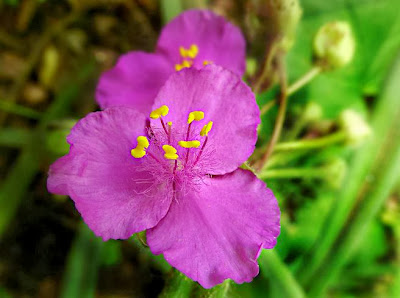Type of Flowers
Spiderwort:
The Spiderwort (Tradescantia), is a genus of an estimated 71 species of perennial plants in the family Commelinaceae, native to the New World from southern Canada south to northern Argentina. They are weakly upright to scrambling plants, growing to 30–60 cm tall, and are commonly found individually or in clumps in wooded areas and fields. The leaves are long, thin and bladelike to lanceolate, from 3–45 cm long. The flowers can be white, pink, or purple, but are most commonly bright blue, with three petals and six yellow anthers. The sap is mucilaginous and clear. A number of the species flower in the morning and when the sun shines on the flowers in the afternoon they close, but can remain open on cloudy days until evening. Unlike most wildflowers of the United States and Canada (other than orchids and lilies), spiderworts are monocots and not dicots.
Though sometimes considered a weed, spiderwort is cultivated for borders and also used in containers. Where it appears as a volunteer, it is often welcomed and allowed to stay.
The first species described, Virginia Spiderwort T. virginiana, is native to the eastern United States from Maine to Alabama, and Canada in southern Ontario. Virginia Spiderwort was introduced to Europe in 1629, where it is cultivated as a garden flower.
Some members of the genus Tradescantia may cause allergic reactions in pets (especially cats and dogs), characterised by red, itchy skin. Notable culprits include T. albiflora (Scurvy Weed); T. spathacea (Moses In The Cradle); and T. pallida (Purple Heart).
The Western Spiderwort T. occidentalis is listed as an endangered species in Canada, where the northernmost populations of the species are found at a few sites in southern Saskatchewan, Manitoba and Alberta; it is however more common further south in the United States south to Texas and Arizona.
The three species of Wandering Jew, one native to eastern Mexico, also belong to the Tradescantia genus. Other names used for various species include Spider-lily, Cradle-lily, Oyster-plant and Flowering Inch Plant.
The name of the genus honours the English naturalists John Tradescant the Elder (ca. 1570s – 1638) and John Tradescant the Younger (1608–1662).




















No comments:
Post a Comment